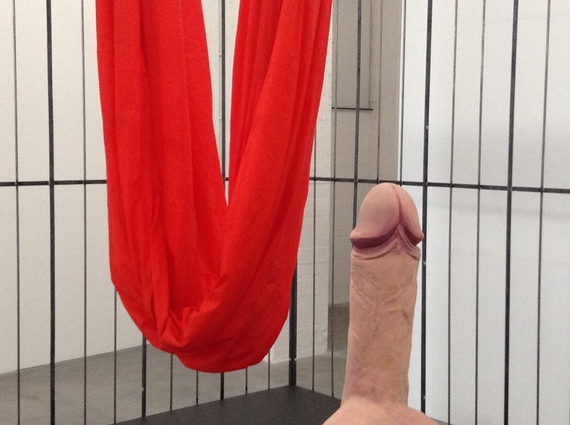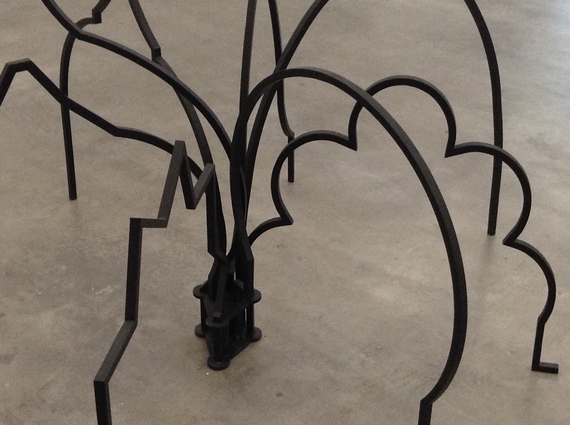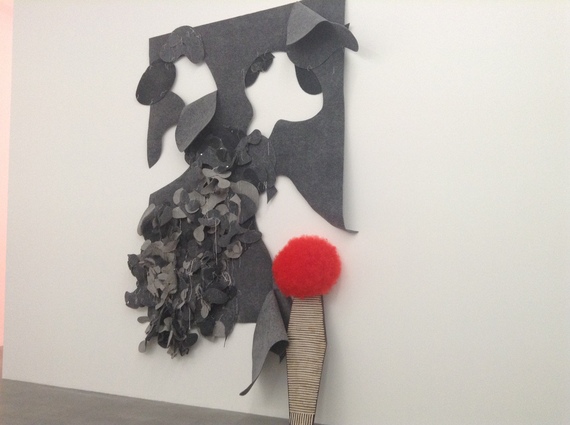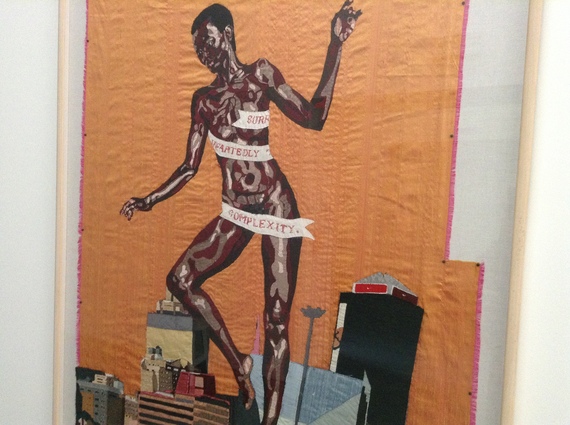Brussels--Six African women artists talk about bodies, sexuality and gender: it's not your everyday show--gathered together in the heart of the bureaucratic capital of Europe--under the rubric Body Talk at the Wiels Center of Contemporary Art. Not only are the works seductively provocative, but the women who came from thousands of miles away for the opening, were charmingly seductive.
Surely the most provocative piece is Ivoirian Valerie Oka's Caged Sex: four walls built of black steel bars contain a red fabric "sex trapeze" and a gargantuan phallus. Oka took delight in building the nearly room-sized cage, and while its content is profoundly political, it is infused with fun and irony.
"The cage returns us to the original mechanism men used to turn women into objects. By putting her on display, the woman becomes 'frozen' in place like animals in a circus," she explained not with old style feminist anger but with a provocative smile. Oka's sex cage, however, is something more as well. It returns us to the infamous Hottentot Venus freak shows of the 19th century when African women were paraded around Britain and Europe, nude in cages, at once recalling the Roman love goddess and reassuring "modern civilized" Westerners that they were different from these "savages."
"The white people could then go on safari and see women with their bare breasts, their pubis shaved and get titillated, even aroused," Oka said. A slightly curved, erect, pink (read white) resin penis watches safely from a corner inside the sex cage--while from time to time a real black naked woman engages in acrobatic dance inside, and a door to the cage rests open. "For me its not porno. It's beautiful. Naturally beautiful. All our complexes, all our cultures, all the mixing of religion and political correctness."
Around the corner in the next room of this converted brewery stands a large black spider. Cast in steel, it is at once an homage to Louise Bourgeois's famous steel spider at the Tate Modern in London. Much smaller than Bourgeois's fearsome female spider, this piece by Algerian sculptor Zoulikha Bouabdellah is formed of eight classic arches binding together Gothic, Moorish, polylobed, Roman, lanzed, zigzag, horseshoe and ogee forms. United as an at once frail and toxic arachnid, the arches invite an array of meditations on the alliances and conflicts of religion, freedom and female sexuality.
"Why does the spider interest me?" Bouabdellah reflected. "Because it symbolizes feminine sex. . . fragility. . . cleverness. It's a small creature but it captures bigger ones in its web." Not the smallest part of its mythology, the spider, especially the Black Widow, recalls primordial male anxiety about women's sex organs, but, Bouabdellah went on, "that is a fear created not by women but by men themselves . . . like forced cliterodectomies in Africa, or in England [where] "they burned the witches because they feared they were too intelligent or in China they bound the feet of girls. In each society there is that violence against women. Women are the unknown and they--men--fear the unknown and they try to control her. It's everywhere a question of dominance and power."
She paused. "It's also about invisible special limits that are not to be crossed [where] nothing is stable nothing is fixed."
A few feet away in another alcove hang three fabric pieces by Kenyan artist Marcia Kure. She calls them The Tree Graces imagined as both provocations and recollections of the marked, vulnerable yet resilient female body, coverings that protect her against easy assault and whose fabrication, he said, afforded her "a kind of healing activity as I stitch together all the textures and colors of our ancestresses." The Graces include the famous and near mythic female warriors of the Kingdom of Dahomey (now Benin) whose brigade survived until the end of the 19th century; Nandi, the mother-protector of 19th century Zulu King Shaka; and Olufunmilayo, the Nigerian nationalist leader and mother of the Afrobeat musician Fela: all powerful women who fused art and ferocity--and all women who have mostly erased from standard histories of colonial Africa.
A half dozen other rooms hold several dozen works from these and others of the six artists, but among the most striking is South African Billie Zangewa's The Rebirth of Black Venus, a silk tapestry that plainly refers to Botticelli's Birth of Venus. Zangewa's black Venus, however, is rising from post-apartheid Johannesburg, its towering skyscrapers dwarfed by a smiling, dancing black woman, her mid-body wrapped by a sash that reads, "surrender whole-heartedly to your complexity."
"It traces personal evolution from self doubt," Zangewa said, "asking, 'am I doing the right things, am I doing what I'm supposed to do, am I whom I'm supposed to be? Or am I just being what other people expect me to
be?'"
Those others being? I asked her.
"Men. Seeing yourself only through the eyes of someone else. So I get to the point where that's not making me happy. And I don't know how to proceed. I go into a place of self examination. I break myself down completely and look at all my components, even the places I never wanted to look. All my negative traits whatever they might be. I shut down and I'm cold. Before I would have pretended to be someone else, but this is a part of who I am. This is about self discovery and embracing every single aspect of myself, all my little faults and imperfections and finding a power in that--coming to a place of self love."
Body Talk is not the first unified collection of trans-African women artists, as one of the participants suggested. "It is the third--ever," curator Koyo Kouch of Senegal corrected with a smile. The works, she wrote in her opening note, "can be seen as so many ways of re-exploring, reintegrating and reincarnating the body."
(Photos by Frank Browning)




